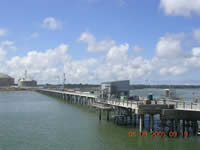CASE STUDY
Project : Atlantic LNG Loading Dock Train 4 Jetty 2
Type Of Project : Marine Jetty
Director in Charge: Anthony Farrell
Design Engineer : Samuel Sooknanan
Design Team : C.E.P. Limited (Structural Engineers)
PresTcon Limited (Contractors )
Bechtel USA (Client)
Date of Commencement: 2002
Date of Completion: 2004
Description :
The Atlantic LNG Loading Dock Train four jetty is located in Point Fortin, the south western region of Trinidad and Tobago. The jetty was designed according to the IBC 2000 codes. The dimensions of the jetty were 36 meters long and 16 meters wide. The jetty structure was to serve as a roadway, a pipe rack and a utility rack. Pre-stressed channel beams were used for the roadway while prestressed octagonal concrete piles were used to support the superstructure; the pile diameters being 24", 20" and 16".
Challenge :
1. The implementation of the International Building Code 2000 presented a problem to the design. The difference in structural systems was especially highlighted in the determination of the period of the jetty. According to the code, there was a cap limit to be applied to the period of a building structure. However from calculations, the jetty's period was larger than the limit imposed by the IBC 2000. If the limiting period prescribed by the IBC 2000 was used, this would have resulted in increased the jetty forces which would have made the jetty's design less economic.
2. The excessive cracking would have resulted in large thermal expansions due to temperature changes. Restraint to this expansion would have been provided by the attained piles and as such large strains and stresses would have been developed in them.
3. The seismic loads acting on the deepest points resulted in large deflection values, which exceeded the allowable deflection limit present in the IBC 2000 code. C.E.P.'s suggestion of using 40" pre-stressed hollow octagonal pile sections was rejected.
4. Some sections of the structure were designed longitudinally with a special moment-resisting frame. This implied that all members had to be continuous so that there would be adequate transfer of moments from one section to another. Unconventional special moment connections had to be designed so as to resist the forces being applied to the structure.
Solutions :
- It was determined in consultation with Dr. S. K. Ghosh, a renowned member of the Earthquake Engineering Research Institute that the period limit applied to a building structure from the IBC 2000 does not apply to the jetty. This limit was imposed by codes due to stiffening elements such as walls in buildings. This is not the case for the jetty.
- The jetty was broken up into three separate structures to limit the effect of thermal expansion due to excessive length. These structures were called trestles, namely, the shore trestle, the central trestles and the sea trestles. The sea trestle was further broken up into two sub-sections. The reduced area limited the stresses that would have been developed from expansion and contraction forces within the concrete. Frame structures were used as supports along with expansion loops and fixed bends as lateral restraints.
- Expansion joints were used to allow for the movement of structures without adversely affecting their functionality. C.E.P. initial solution was rejected. Raked piles were proposed as another alternative to the pre-stressed hollow octagonal sections in the deep end structure. Although there was an ease of construction, there was a dramatic increase in the number of piles. Thus the design checks for each pile became more meticulous, as each pile was checked to ensure that each value was within two moment-interaction curves; pre-cast and pre-stressed.
- Thus the alternative was to increase in the number of piles. Increase design checks on piles to ensure that each value was within two moment-interaction curves; pre-cast and pre-stressed.
- NMB splices were used as the connections for longitudinal directions. This was applied to the roadway channels over pile caps or bents. The diagram below shows the connection detail
Results :
Despite the various design challenges that existed, the jetty was designed and constructed and is still in full service.
